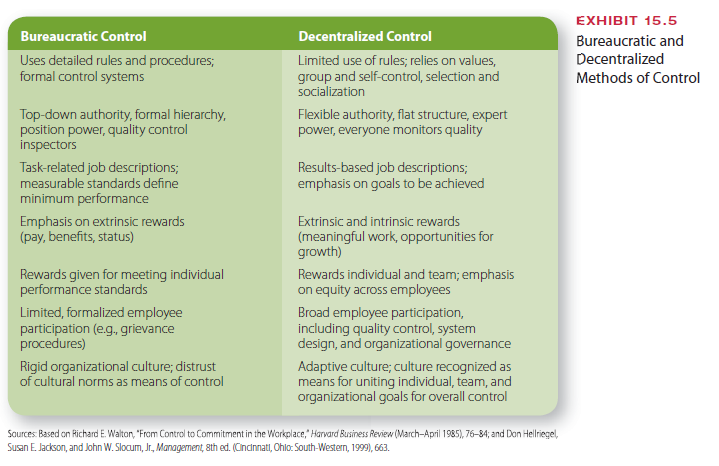Managers’ approach to control is changing in many of today’s organizations. In connection with the shift to employee participation and empowerment, many companies are adopting a decentralized rather than a bureaucratic control process. Bureaucratic control and decen- tralized control represent different philosophies of corporate culture, which was discussed in Chapter 2. Most organizations display some aspects of both bureaucratic and decentral- ized control, but managers generally emphasize one or the other, depending on the organi- zational culture and their own beliefs about control.
Bureaucratic control involves monitoring and influencing employee behavior through the extensive use of rules, policies, hierarchy of authority, written documentation, reward systems, and other formal mechanisms.20 In contrast, decentralized control relies on cul- tural values, traditions, shared beliefs, and trust to foster compliance with organizational goals. Managers operate on the assumption that employees are trustworthy and willing to perform effectively without extensive rules and close supervision.
Exhibit 15.5 contrasts the use of bureaucratic and decentralized methods of control. Bureaucratic methods define explicit rules, policies, and procedures for employee behavior. Control relies on centralized authority, the formal hierarchy, and close personal supervision. Responsibility for quality control rests with quality control inspectors and supervisors rather than with employees. Job descriptions generally are specific and task related, and managers de-fine minimal standards for acceptable employee performance. In exchange for meeting the standards, individual employees are given extrinsic rewards such as wages, benefits, and possi- bly promotions up the hierarchy. Employees rarely participate in the control process, with any participation being formalized through mechanisms such as grievance procedures. With bu- reaucratic control, the organizational culture is somewhat rigid, and managers do not consider culture a useful means of controlling employees and the organization. Technology often is used to control the flow and pace of work or to monitor employees, such as by measuring how long employees spend on phone calls or how many keystrokes they make at the computer.

Bureaucratic control techniques can enhance organizational efficiency and effectiveness. Many employees appreciate a system that clarifies what is expected of them, and they may be motivated by challenging, but achievable, goals.21 However, although many managers effectively use bureaucratic control, too much control can backfire. Employees resent being watched too closely, and they may try to sabotage the control system. One veteran truck driver expressed his unhappiness with electronic monitoring to a Wall Street Journal re- porter investigating the use of devices that monitor truck locations. According to the driver, “It’s getting worse and worse all the time. Pretty soon they’ll want to put a chip in the driv- ers’ ears and make them robots.” He added that he occasionally escapes the relentless monitoring by parking under an overpass to take a needed nap out of the range of the surveillance satellites.22
In addition, some managers take bureaucratic control to an extreme, hovering over employees and micromanaging every detail, which is inef- ficient as well as damaging to morale and motivation.23 The Qwest call center in Idaho Falls was about to go under partly as a result of overcon- trolling front-line supervisors, until a new manager arrived with a differ- ent philosophy, as described a bit later in this chapter.
Decentralized control is based on values and assumptions that are almost opposite to those of bureaucratic control. Rules and procedures are used only when necessary. Managers rely instead on shared goals and values to control employee behavior. The organization places great em- phasis on the selection and socialization of employees to ensure that workers have the appropriate values needed to influence behavior toward meeting company goals. No organization can control employees 100 percent of the time, and self-discipline and self-control are what keep workers performing their jobs up to standard. Empowerment of employ- ees, effective socialization, and training all can contribute to internal standards that provide self-control.
With decentralized control, power is more dispersed and is based on knowledge and experience as much as position. The organizational struc- ture is flat and horizontal, as discussed in Chapter 7, with flexible authority and teams of workers solving problems and making improvements. Everyone is involved in quality control on an ongoing basis. Job descriptions generally are results-based, with an emphasis more on the outcomes to be achieved than on the specific tasks to be performed. Managers use not only extrinsic rewards such as pay but also the intrinsic rewards of meaningful work and the opportunity to learn and grow. Technology is used to empower employees by giving them the information they need to make effective deci- sions, work together, and solve problems. People are rewarded for team and organizational success as well as their individual performance, and the emphasis is on equity among employees. Employees participate in a wide range of areas, including setting goals, determining standards of perfor- mance, governing quality, and designing control systems.
With decentralized control, the culture is adaptive, and managers recognize the importance of organizational culture for uniting individual, team, and organizational goals for greater overall control. Ideally, with decentralized control, employees will pool their areas of expertise to arrive at procedures that are better than managers could come up with working alone.
Source: Daft Richard L., Marcic Dorothy (2009), Understanding Management, South-Western College Pub; 8th edition.

I went over this internet site and I conceive you have a lot of good info , saved to fav (:.
I think other web site proprietors should take this web site as an model, very clean and excellent user genial style and design, as well as the content. You are an expert in this topic!